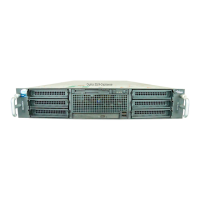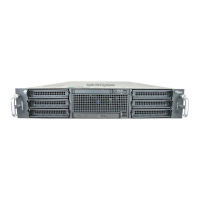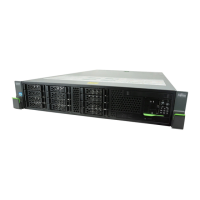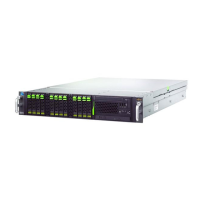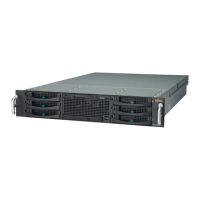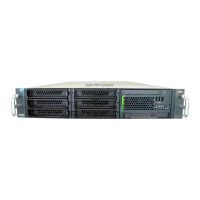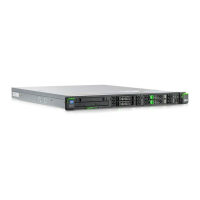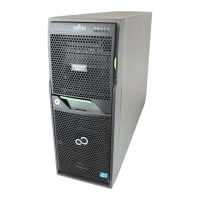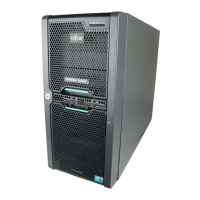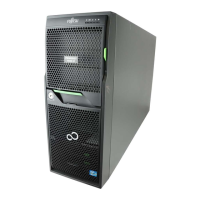Do you have a question about the Fujitsu PRIMERGY RX300 S7 and is the answer not in the manual?
Essential safety and operational warnings before using the server.
Defines the manual's purpose, intended users, and required background knowledge.
Lists and describes related manuals and additional information sources.
Explains symbols and text formatting used throughout the manual for clarity.
Introduces the Customer Self Service (CSS) concept for component identification and replacement.
Details system board, UFM slot, and Trusted Platform Module (TPM) options.
Covers expansion slots, hard disk drive configurations, and accessible drive bays.
Explains power supply, cooling systems, and remote management features (iRMC S3, ServerView).
Technical specifications for the server's system board and processor.
Details memory slots, type, capacity, and protection mechanisms.
Describes server interfaces (USB, LAN) and onboard controllers (RAID, SATA).
Covers dimensions, weight, ambient conditions, and noise levels of the server.
Specifies electrical ratings for AC and optional DC power supply units.
Lists supported screen resolutions, refresh rates, and color depths.
Outlines compliance with various safety, EMC, and industry standards.
Provides critical safety guidelines for handling and operating the server.
CAUTION notes regarding installation, environmental conditions, and initial startup.
CAUTION notes on operating temperatures, power connection, and electrical safety.
Further safety guidance on power sockets, cabling, and emergency procedures.
Safety advice for installing expansions, handling components, and preventing static discharge.
Safety precautions and disposal guidelines for batteries used in the server.
Best practices and safety instructions for using CDs, DVDs, and optical drives.
Details on the optical drive's laser class and associated safety warnings.
Guidelines for handling components sensitive to electrostatic discharge (ESD).
Notes on cleaning, keeping manuals, ENERGY STAR, and CE conformity.
Statement on FCC compliance for Class A digital devices and potential interference.
CAUTION notes and instructions for safely transporting the server.
Safety precautions and best practices for rack mounting the server.
Information on environmentally friendly design, energy saving, and packaging.
Guidelines for proper disposal and recycling of the server and its components.
General CAUTION for hardware installation, emphasizing safety and referring to relevant sections.
Step-by-step instructions and safety notes for unpacking the server.
Procedures and safety information for mounting and dismounting the server in a rack.
Details features of Fujitsu rack systems and compatibility with 3rd party racks.
Explains the function and location of external connectors on the server.
Instructions for connecting essential peripherals like keyboard, mouse, and monitor.
Detailed guide on connecting the server to AC and optional DC power sources.
Specific instructions for connecting the optional DC hot-plug power supply unit.
Instructions on how to use the cable clamp to secure power cords for safety.
General safety and procedural notes for connecting and disconnecting various cables.
Guidance on using appropriate shielded cables for EMC compliance.
General safety warnings and CAUTION notes for server startup and operation.
Introduces front-side controls and indicators with a reference diagram.
Detailed description of front panel buttons, indicators, and the ID card.
Explains the function of the On/Off button and the NMI button.
Describes the function of the Reset and ID buttons and their indicators.
Details the Power-on, HDD/SSD Activity, and Global Error indicators.
Explains the CSS (yellow) and ID (blue) indicators on the control panel.
Describes indicators for HDD BUSY and HDD FAULT for hard disk drives.
Describes indicators for SSD BUSY and SSD FAULT for solid state drives.
Overview of the Global Error/CSS/ID indicator on the rear connection panel.
Explains the CSS (yellow) and ID (blue) indicators on the rear panel.
Describes the LAN link/transfer and LAN speed indicators.
Details the status indicators on the hot-plug power supply unit.
Explains the status indicators for the hot-plug fan modules.
Provides instructions for safely switching the server on and off.
Step-by-step guide for powering on the server, including first-time startup.
Procedures for properly shutting down the server and entering standby mode.
Explains how to perform a hard power off using the On/Off button.
Details options for controlling server power status via the iRMC S3 interface.
Information on configuring the server and installing the operating system.
Step-by-step guide for configuring the integrated SAS/SATA controller.
Instructions for configuring the SAS/SATA RAID controller with MegaRAID functionality.
Guide to using ServerView IM for server setup and operating system installation.
Steps for manual server configuration and operating system installation.
Instructions for safely cleaning the server casing and peripherals.
Explains how to use BIOS Setup security features for data protection.
General safety warnings and CAUTION notes for troubleshooting server issues.
Troubleshooting steps for when the power-on indicator remains unlit.
Troubleshooting steps for when the server unexpectedly switches itself off.
Troubleshooting steps for blank monitor screens or display problems.
Troubleshooting for flickering stripes or display drifts on the monitor screen.
Troubleshooting for system boot failures and drives reported as 'dead'.
Steps to correct incorrect system date and time settings.
Troubleshooting unrecognized devices, expansion cards, and temperature warnings.
Troubleshooting defective drives and interpreting on-screen error messages.
Troubleshooting steps for unresponsive keyboard or mouse input.
Troubleshooting steps for when the optical drive cannot read data.
Essential safety and operational warnings before using the server.
Defines the manual's purpose, intended users, and required background knowledge.
Lists and describes related manuals and additional information sources.
Explains symbols and text formatting used throughout the manual for clarity.
Introduces the Customer Self Service (CSS) concept for component identification and replacement.
Details system board, UFM slot, and Trusted Platform Module (TPM) options.
Covers expansion slots, hard disk drive configurations, and accessible drive bays.
Explains power supply, cooling systems, and remote management features (iRMC S3, ServerView).
Technical specifications for the server's system board and processor.
Details memory slots, type, capacity, and protection mechanisms.
Describes server interfaces (USB, LAN) and onboard controllers (RAID, SATA).
Covers dimensions, weight, ambient conditions, and noise levels of the server.
Specifies electrical ratings for AC and optional DC power supply units.
Lists supported screen resolutions, refresh rates, and color depths.
Outlines compliance with various safety, EMC, and industry standards.
Provides critical safety guidelines for handling and operating the server.
CAUTION notes regarding installation, environmental conditions, and initial startup.
CAUTION notes on operating temperatures, power connection, and electrical safety.
Further safety guidance on power sockets, cabling, and emergency procedures.
Safety advice for installing expansions, handling components, and preventing static discharge.
Safety precautions and disposal guidelines for batteries used in the server.
Best practices and safety instructions for using CDs, DVDs, and optical drives.
Details on the optical drive's laser class and associated safety warnings.
Guidelines for handling components sensitive to electrostatic discharge (ESD).
Notes on cleaning, keeping manuals, ENERGY STAR, and CE conformity.
Statement on FCC compliance for Class A digital devices and potential interference.
CAUTION notes and instructions for safely transporting the server.
Safety precautions and best practices for rack mounting the server.
Information on environmentally friendly design, energy saving, and packaging.
Guidelines for proper disposal and recycling of the server and its components.
General CAUTION for hardware installation, emphasizing safety and referring to relevant sections.
Step-by-step instructions and safety notes for unpacking the server.
Procedures and safety information for mounting and dismounting the server in a rack.
Details features of Fujitsu rack systems and compatibility with 3rd party racks.
Explains the function and location of external connectors on the server.
Instructions for connecting essential peripherals like keyboard, mouse, and monitor.
Detailed guide on connecting the server to AC and optional DC power sources.
Specific instructions for connecting the optional DC hot-plug power supply unit.
Instructions on how to use the cable clamp to secure power cords for safety.
General safety and procedural notes for connecting and disconnecting various cables.
Guidance on using appropriate shielded cables for EMC compliance.
General safety warnings and CAUTION notes for server startup and operation.
Introduces front-side controls and indicators with a reference diagram.
Detailed description of front panel buttons, indicators, and the ID card.
Explains the function of the On/Off button and the NMI button.
Describes the function of the Reset and ID buttons and their indicators.
Details the Power-on, HDD/SSD Activity, and Global Error indicators.
Explains the CSS (yellow) and ID (blue) indicators on the control panel.
Describes indicators for HDD BUSY and HDD FAULT for hard disk drives.
Describes indicators for SSD BUSY and SSD FAULT for solid state drives.
Overview of the Global Error/CSS/ID indicator on the rear connection panel.
Explains the CSS (yellow) and ID (blue) indicators on the rear panel.
Describes the LAN link/transfer and LAN speed indicators.
Details the status indicators on the hot-plug power supply unit.
Explains the status indicators for the hot-plug fan modules.
Provides instructions for safely switching the server on and off.
Step-by-step guide for powering on the server, including first-time startup.
Procedures for properly shutting down the server and entering standby mode.
Explains how to perform a hard power off using the On/Off button.
Details options for controlling server power status via the iRMC S3 interface.
Information on configuring the server and installing the operating system.
Step-by-step guide for configuring the integrated SAS/SATA controller.
Instructions for configuring the SAS/SATA RAID controller with MegaRAID functionality.
Guide to using ServerView IM for server setup and operating system installation.
Steps for manual server configuration and operating system installation.
Instructions for safely cleaning the server casing and peripherals.
Explains how to use BIOS Setup security features for data protection.
General safety warnings and CAUTION notes for troubleshooting server issues.
Troubleshooting steps for when the power-on indicator remains unlit.
Troubleshooting steps for when the server unexpectedly switches itself off.
Troubleshooting steps for blank monitor screens or display problems.
Troubleshooting for flickering stripes or display drifts on the monitor screen.
Troubleshooting for system boot failures and drives reported as 'dead'.
Steps to correct incorrect system date and time settings.
Troubleshooting unrecognized devices, expansion cards, and temperature warnings.
Troubleshooting defective drives and interpreting on-screen error messages.
Troubleshooting steps for unresponsive keyboard or mouse input.
Troubleshooting steps for when the optical drive cannot read data.
| Tcase | 77.4 °C |
|---|---|
| Bus type | QPI |
| Stepping | C2 |
| FSB Parity | No |
| Scalability | 2S |
| Processor cache | 20 MB |
| Processor cores | 8 |
| Processor model | E5-2650 |
| System bus rate | 8 GT/s |
| Processor series | Intel Xeon E5-2600 |
| Processor socket | LGA 2011 (Socket R) |
| Processor threads | 16 |
| Processor codename | Sandy Bridge EP |
| Motherboard chipset | Intel C600 |
| Processor frequency | 2 GHz |
| Processor cache type | Smart Cache |
| Processor manufacturer | Intel |
| Processor package size | 52.5 x 45.0 mm |
| Processor front side bus | - MHz |
| Processor boost frequency | 2.8 GHz |
| Processor operating modes | 64-bit |
| Graphics & IMC lithography | 32 nm |
| PCI Express configurations | x4, x8, x16 |
| Supported instruction sets | AVX |
| Thermal Design Power (TDP) | 95 W |
| Number of processors installed | 2 |
| CPU multiplier (bus/core ratio) | 28 |
| Physical Address Extension (PAE) | 46 bit |
| Maximum number of PCI Express lanes | 40 |
| Memory types supported by processor | DDR3-SDRAM |
| Memory channels supported by processor | Quad |
| Memory clock speeds supported by processor | 800, 1066, 1333, 1600 MHz |
| Memory bandwidth supported by processor (max) | 51.2 GB/s |
| Maximum internal memory supported by processor | 750 GB |
| Intelligent Platform Management Interface (IPMI) support | Yes |
| HDD size | 2.5 \ |
| RAID levels | 0, 1, 10 |
| HDD interface | Serial ATA |
| Optical drive type | DVD Super Multi |
| Total storage capacity | 0 GB |
| Maximum storage capacity | - TB |
| Number of HDDs installed | 0 |
| Number of HDDs supported | 4 |
| Memory slots | 24 |
| Internal memory | 16 GB |
| Memory clock speed | 1600 MHz |
| Maximum internal memory | 768 GB |
| Memory layout (slots x size) | 2 x 8 GB |
| LAN controller | Intel® I350 |
| Cabling technology | 10/100/1000Base-T(X) |
| Ethernet interface type | Fast Ethernet, Gigabit Ethernet |
| PS/2 ports quantity | - |
| USB 2.0 ports quantity | 10 |
| PCI Express slots version | 3.0 |
| PCI Express x8 (Gen 3.x) slots | 5 |
| Compatible operating systems | - Microsoft Hyper-V Server 2008 R2\\r - Microsoft Windows Server 2008 R2 Datacenter\\r - Microsoft Windows Server 2008 R2 Enterprise\\r - Microsoft Windows Server 2008 R2 Standard\\r - Microsoft Windows Web Server 2008 R2\\r - Microsoft Windows HPC Server 2008 R2 Suite\\r - Microsoft Windows Small Business Server 2011 Premium Add-On\\r - Microsoft Windows Small Business Server Standard 2011\\r - Microsoft Windows Server 2008 Datacenter\\r - Microsoft Windows Server 2008 Enterprise\\r - Microsoft Windows Server 2008 Standard\\r - Microsoft Windows Web Server 2008\\r - VMware vSphere 5.0 Embedded\\r - VMware vSphere 5.0\\r - VMware vSphere 4.1\\r - VMware vSphere 4.1 Embedded\\r - VMware vSphere 4.1 Installable\\r - Novell SUSE Linux Enterprise Server 11\\r - Novell SUSE Linux Enterprise Server 10\\r - Novell SUSE Linux Enterprise Server 10 with XEN\\r - Red Hat Enterprise Linux 6\\r - Red Hat Enterprise Linux 5\\r - Red Hat Enterprise Linux 5 with XEN\\r - Citrix XenServer |
| Chassis type | Rack (2U) |
| Power supply | 450 W |
| Power supply input frequency | 50 - 60 Hz |
| Intel® Virtualization Technology (Intel® VT) | VT-d, VT-x |
| Sustainability certificates | ENERGY STAR |
| Certification | GS, CE, CSAc/us, FCC A, CB, RoHS, WEEE, VCCI, CCC, C-Tick |
| Operating temperature (T-T) | 10 - 35 °C |
| Operating relative humidity (H-H) | 10 - 85 % |
| Processor ARK ID | 64590 |
| Intel Secure Key Technology version | 1.00 |
| Intel Identity Protection Technology version | 0.00 |
| Depth | 770 mm |
|---|---|
| Width | 482.6 mm |
| Height | 86.9 mm |
| Weight | 25000 g |
